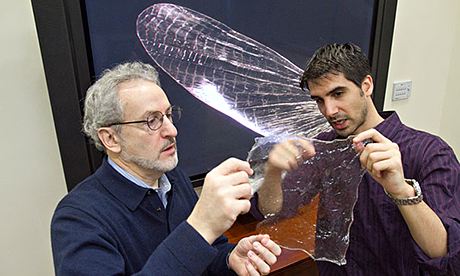Ian Sample
“The history of materials is a history of mistakes,” says Mark Miodownik, a materials scientist at University College London, who traces his own fascination with materials to the moment he was stabbed in the back with a razor while ambling to school one day.
The remark is spot on. Over the centuries, scientists have been as likely to stumble on the next wonder material during a botched experiment as to create it from scratch on purpose. The tradition continues today: more than one material tipped to revolutionise the world, or at least give us better gadgets, came about through serendipity, if not outright blunders.
But the chance discovery of useful materials might not carry on for much longer. Scientists are now turning to computers to design materials and work out their properties before going anywhere near a laboratory or workshop. Some of the newest materials that are getting scientists fired up exist only in theory. The goal now is to make them a reality.
The materials here are so new that their ultimate applications are still tentative – or not even being guessed at. But each has the potential to be transformative. If the history of materials is any guide, how we eventually use them will, in part, be discovered accidentally, too.
Graphene
The Friday evening antics that led to the invention of graphene have become the stuff of scientific legend. Andre Geim and Konstantin Novoselov at Manchester University were playing around with Scotch tape and a lump of graphite when they found they could make sheets of carbon one atom thick. That was in 2004. They have since shared the Nobel prize, become Sirs and been rewarded with a £61m National Graphene Institute.
And all for good reason. Graphene is an extraordinary material. Apart from its many other properties, it’s immensely strong, flexible, transparent and conductive. This makes it perfect for the next generation of electronic devices, the sort that might be sewn into our clothing, slapped on drinks bottles and cans of food or rolled up and tucked in our pockets. Last week, Zhaohui Zhong at the University of Michigan described how graphene might be used to make night-vision contact lenses.
“Graphene has huge potential,” says Andrea Ferrari, director of the Cambridge Graphene Centre. “You don’t usually find a material that has applications in so many different areas.”

Spider silk
Long, long ago, in the history of science, there was a time when researchers didn’t speak of spider silk as the perfect material from which to manufacture bulletproof vests. The application was touted around after researchers teased out the silk’s molecular structure and from that came to understand its fantastic strength and flexibility.
Decades on, the prospect of a vibrant market for personal body armour spun from spider silk probably overestimated the dangers of modern life as much as the practical hurdles that come with using the material.
“You can’t use spider silk to make a bulletproof vest. It’s too extensible. It would catch the bullet, but not before the bullet had passed through your body,” says Fritz Vollrath at the Oxford Silk Group. The words of caution don’t end there. “Can you use it as a material? Probably not. It has to be collected from a spider, and that’s not economically feasible.”
And yet scientists remain fascinated. That’s because it’s an exquisite material to learn from and will, Vollrath says, inspire researchers to make better materials in the future. Spider silk is made from a biopolymer called an aquamelt, which can be spun at room temperature 1,000 times more efficiently than plastics that need to be heated up and cooled down. By controlling the rate at which the silk is spun, a spider can control the stiffness or flexibility of the fibres. The goal for researchers is to make other materials that mimic spider silk’s tricks.
Metamaterials
Harry Potter. Cloak. Invisible. Full house! Metamaterials bingo remains – inexplicably – a niche hobby, but there is no doubting the genuine excitement around the materials. They owe their existence, in large part, to the enormously competitive microchip industry, which has refined manufacturing at the nano scale. Metamaterials are made with the same technology, but their design is so precise that scientists can control how electrons inside the materials respond when light – or other electromagnetic waves – strike them. This makes it possible to manipulate radiation like never before.
And yes, metamaterials can – to some extent – bend light around an object, rendering that object invisible. “You have to structure the material on a length scale that’s short compared to the wavelength you’re interested in, so for visible light that means on the nano scale,” says Chris Phillips at Imperial College’s physics department, where much of the work on cloaking devices has been pioneered.
The materials themselves vary. To control radiowaves, you can use copper and fibreglass. To make metamaterials that bend infrared light, you can use semiconductors. Cloaking devices are still little more than party tricks, but that’s changing. Objects can be hidden at some wavelengths and not others, or only under specific conditions, such as with polarised light, or from a particular angle. It’s unlikely a cloak will ever make something completely vanish: even if an object is invisible to the naked eye, there’s always radar and infrared imaging to turn to. “As a general rule, an object that’s invisible at one wavelength will be visible at another. You can make a cloak work across a range of wavelengths, but not the whole electromagnetic spectrum,” says Phillips.
Shrilk
What to call a material made from leftover shrimp shells and proteins derived from silk? Javier Fernandez and Don Ingber at the Wyss Institute at Harvard plumped for shrilk, and the name has stuck.
Shrilk was inspired by research into the tough skins of insects. The coating is made from layers of a material called chitin and a protein called fibroin. In one arrangement, the material is strong and rigid enough to form the insect’s protective exoskeleton. What intrigued the Harvard group was that simple tweaks to the material – specifically the amount of water bound inside it – changed its behaviour dramatically. Without water the material is stiff, but with water the coating becomes very flexible.
 Don Ingber, director at the Wyss Institute, left, and postdoc Javier Fernandez have developed a new material called Shrilk. Photograph: Jon Chase/Harvard UniversityFernandez and Ingber used fibroin from silk worms and chitosan, a material similar to chitin, to make their first batch of shrilk. They then played with the water bound inside the material to vary its properties. They can form strong, transparent sheets of shrilk that are biodegradable and even enrich the soil like a fertiliser as it breaks down. Bob Cunningham, also at the Wyss Institute, says shrilk is an environmentally friendly alternative to plastics. “It might not make sense to make the trash bin that you’re going to use for 10 years out of this material, but a trash bag you might fill up in a day or a week that goes to landfill? That makes a lot more sense,” says Cunningham. The components are FDA-approved for use in the body, where they could find a role as sutures, or scaffolds for growing new tissues that dissolve when they are no longer needed.
Don Ingber, director at the Wyss Institute, left, and postdoc Javier Fernandez have developed a new material called Shrilk. Photograph: Jon Chase/Harvard UniversityFernandez and Ingber used fibroin from silk worms and chitosan, a material similar to chitin, to make their first batch of shrilk. They then played with the water bound inside the material to vary its properties. They can form strong, transparent sheets of shrilk that are biodegradable and even enrich the soil like a fertiliser as it breaks down. Bob Cunningham, also at the Wyss Institute, says shrilk is an environmentally friendly alternative to plastics. “It might not make sense to make the trash bin that you’re going to use for 10 years out of this material, but a trash bag you might fill up in a day or a week that goes to landfill? That makes a lot more sense,” says Cunningham. The components are FDA-approved for use in the body, where they could find a role as sutures, or scaffolds for growing new tissues that dissolve when they are no longer needed.
Stanene
Stanene is radical not only for its properties, but also for what it represents. Forget accidental discoveries from lab tests gone wrong; this material was designed on a computer, and its extraordinary behaviour worked out from theory. Only now are researchers trying to make the stuff to see if it delivers on those promises in the real world.
Stanene was created – virtually, that is – by Shoucheng Zhang at Stanford University. Scientists call it a topological insulator, but the name isn’t wildly helpful. Stanene is an insulator on the inside, and a conductor on the outside. Thin layers of stanene – or one-atom-thick sheets of tin – are essentially all surface, and should conduct electricity with 100% efficiency.
Materials conduct electricity when electrons flow through them. However, in most materials, the electrons are held up by impurities and other features that give rise to resistance. This resistance generates heat, and so electronics must be cooled to stop them melting. Stanene promises to change all that. The structure of the material allows electrons to shoot along channels with no resistance whatsoever. Add a little fluorine and, according to Zhang, the material will have zero resistance at more than 100C (212F).
Zhang sees stanene as the natural successor to copper interconnects in computers. This might seem niche, but atomically thin connections that don’t heat up would enable designers to miniaturise electronics even more. Ultimately, Zhang says stanene could replace silicon as a cheap and abundant material from which to make computer chips.


